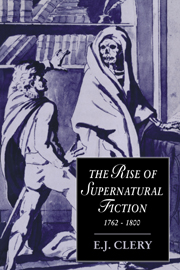Book contents
- Frontmatter
- Contents
- List of illustrations
- Acknowledgements
- Introduction
- PART I TECHNIQUES OF GHOST-SEEING
- PART II THE BUSINESS OF ROMANCE
- 3 The advantages of history
- 4 Back to the future
- 5 The value of the supernatural in a commercial society
- PART III THE STRANGE LUXURY OF ARTIFICIAL TERROR
- PART IV MAGICO-POLITICAL TALES
- Afterword
- Notes
- Bibliography
- Index
- CAMBRIDGE STUDIES IN ROMANTICISM
4 - Back to the future
Published online by Cambridge University Press: 03 December 2009
- Frontmatter
- Contents
- List of illustrations
- Acknowledgements
- Introduction
- PART I TECHNIQUES OF GHOST-SEEING
- PART II THE BUSINESS OF ROMANCE
- 3 The advantages of history
- 4 Back to the future
- 5 The value of the supernatural in a commercial society
- PART III THE STRANGE LUXURY OF ARTIFICIAL TERROR
- PART IV MAGICO-POLITICAL TALES
- Afterword
- Notes
- Bibliography
- Index
- CAMBRIDGE STUDIES IN ROMANTICISM
Summary
GOTHIC ALLEGORY
For much of the eighteenth century the term ‘gothic’ was used loosely to describe any time from the fall of the Roman Empire to the reign of James I. But from the 1760s the Scottish ‘historical school’, including James Steuart and Adam Smith, began defining feudalism in a more analytical way, as a distinctive stage in historical evolution with a prevailing mode of subsistence giving rise to characteristic social, intellectual and political structures. At around the same time, Richard Hurd was effecting a similar change in literary history. In Letters on Chivalry and Romance (1762), he drew on French scholarship in order to explain the cultural logic of the gothic era: ‘Chivalry was no absurd and freakish institution, but the natural and even sober effect of the feudal policy; whose turbulent genius breathed nothing but war, and was fierce and military even in its amusements.’ By the same token, ancient romances could not be judged by anachronistic modern standards. Tales of enchantment, with all their apparent irrationality, ‘shadowed out’ the realities of their times: giants ‘were oppressive feudal Lords, and every Lord was to be met with, like the Giant, in his strong hold, or castle’, their wretched and equally violent dependants ‘were the Savages of Romance’. The fantasies of the past were by this means rendered comprehensible and thereby tolerable for the modern-day reader; but what would be the result if the same explanatory method were applied to a supernatural fiction of the present?
- Type
- Chapter
- Information
- The Rise of Supernatural Fiction, 1762–1800 , pp. 68 - 79Publisher: Cambridge University PressPrint publication year: 1995

